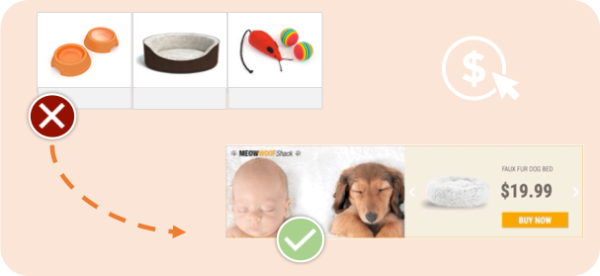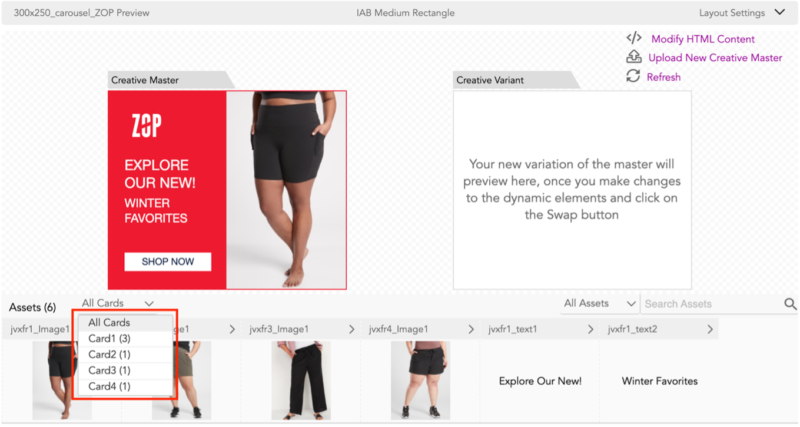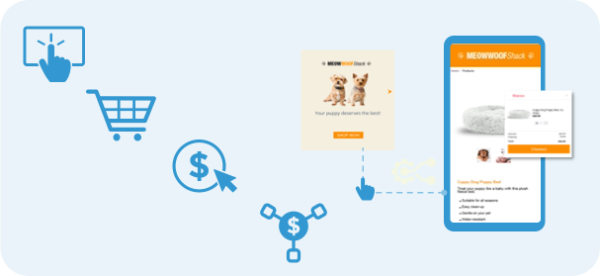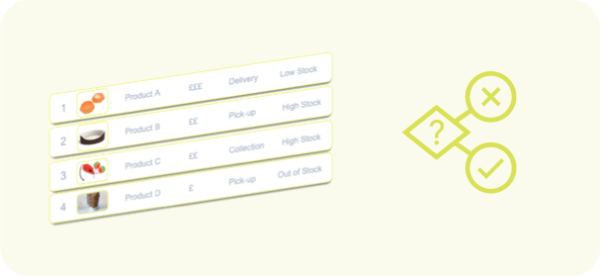Elevate your brand’s commerce marketing by avoiding these common pain points. With new capabilities launching on Jivox, personalized commerce marketing becomes more streamlined, consistent and effective. Take a look below at some of our recommendations and how you can take advantage of these via Jivox.
#1 Ditch Tired, Templated Product Ads For Better Engagement
Fed up of tired, templated automated product ads?

We have all experienced painfully generic automated retargeting ads, often displaying rows of products that either don’t fit our needs or are presented in a rather uninspiring format – almost as if you were looking directly into a retailer’s warehouse of products.
Dynamic Product Ads (DPAs) shouldn’t have to sacrifice brand guidelines or creative expression, just to automate production. In addition to showing ads for all available products, it’s important to remember to make the ads relevant and engaging to the spectrum of potential customers.

Jivox Dynamic Product Ads empower brands to achieve creative flexibility whilst providing production efficiencies. The Dynamic Canvas Studio now includes support for Carousel ads natively, allowing brands to utilize Jivox’s industry-leading creative automation capabilities to produce cards of images or videos to showcase products, offers and the brand’s original look and feel, based on product feeds.
- Creative Flexibility To Extend Brand Image: A brand’s look and feel can be carried over to engaging Dynamic Product Ads to ensure the ads look curated and to drive up engagement.
- Automates Production For Retailers With Large Product Catalogs: speed up the time to go-live by automating ad creation for every product in the brand catalog, without sacrificing creative freedom.
- Omnichannel Delivery For A Consistent Experience: Jivox can push personalized ads across programmatic display, video, social, native and more from a unified workflow; so brands can save time and users see consistent messaging.
3 tips to make DPAs more engaging instantly:
- Utilize your preferred design tools, such as Adobe Creative Cloud, to produce on-brand background styles, price stickers, labels and custom copy to complement the product images.
- Achieve a consistent brand experience across channels such as Facebook, Instagram and Display by building an omnichannel campaign in a platform that can push the creative to many ad formats.
- Combine with an offer feed to ensure discounts and limited-time deals are promoted loud and clear within the card creatives.
#2 Showcase Best-Selling Products To New Prospects
Not sure what products to showcase to lesser-known prospective customers?

Dynamic Product Ads work especially well with retargeting strategies due to the known data on users, but what about unknown users where there are less tangible signals about what a user is looking for?
Personalization takes many forms and effective strategies involve a combination of audience data, contextual triggers and behavioral recommendations.
Bestseller Recommendations expands Jivox’s robust Recommendation Engine to take into account a brand’s most popular products and test these amongst users to gauge interests and increase relevance; driving up the likelihood of purchases.
- Little or No Data Required On User’s Previous Engagements: as this is a generic bestseller list from all customer conversion data, a selection of engaging products can be shown without any prior knowledge of customer
- Optimize From Day One: bestseller data can be incorporated into a campaign launch from the beginning, whilst user engagement data builds up to power more advanced optimization.
- Iterate on Multi-Product Ads to Improve Engagement: best-selling products have high potential to drive more engagement with the brand’s ads, which in turn collects more data on user intent that can be used to adapt campaign strategy.
3 different techniques to recommend the perfect products to users:
- Behavioral-based clustering groups users based on historical engagement or preferences, so brands can infer what users may be interested in.
- Product-based clustering uses tags, categories and other attributes to group similar products and recommend other items to the user.
- Bestseller lists ensure the most popular items can be ranked and displayed in carousel ads to users where there is no more granular data on the user interests, to increase engagement and drive a first interaction.
#3 Remove Friction Between The Ad & Checkout Process To Prevent Drop-Offs
Lack of visibility into purchases on external retailers?
High clicks but high drop-offs before converting?

Ever seen an ad for a product and then clicked-through, only to be taken out of your current app and onto a confusing landing page where you cannot find the product?
Sometimes the journey after the click on an ad can be disjointed and confusing, or worse, show completely different product versions to what was shown in the ad. This can occur in occasions where the brand itself does not sell the product directly, but rather links out to a selection of external retailers.
This can introduce friction in the conversion process as users try to familiarize themselves with the e-commerce partner in question, try to find the specific product version and take several more steps (such as creating an account, providing payment details etc.) to complete the purchase.
Headless Commerce removes the need to leave the branded ad experience at all; offering a dynamic, custom landing page that allows the customer to complete the sale right within the branded environment without getting lost on external e-commerce platforms. Jivox can facilitate this with our partnership with Shoppable ™ that unlocks connections to many e-tailers and offers expanded insights into purchase behavior to power improved personalized commerce marketing.
- One-Click Commerce with A Choice of e-Retailers: Take users directly to a responsive custom landing page from the ad, to minimize the effort on the user side and fast-track the checkout process with a selection of retailers.
- Consistent Brand Experience: Brands can control the look and feel of where the user lands after clicking an ad, rather than a disjointed experience pushing the user out to external retailers websites.
- More Insights Into Purchase Activity: All purchase activity is tracked in real-time, allowing brands to tie purchase data back to the assets used in the ads.
2 ways to prevent drop-offs in the journey from ad to checkout:
- Make Ads Shoppable by including direct links or tags to products in the ad creative or allowing the completion of the purchase within the ad experience itself.
- Optimize the Customer Journey by first understanding each channel’s role in the purchase process, tailoring the messaging across each with effective, branded storytelling.
#4 Maximize Product & Offer Feeds Utility To Power Decisioning
Overwhelmed by volumes of products with different availability, pricing and messaging?

Product and Offer Feeds contain a wealth of information about the products stocked by a brand including stock availability, regional delivery options, pricing and more.
Some of these elements can be volatile and difficult to keep track of. Without attentive monitoring of product stock levels or offer expiry dates, users can be presented with ads for products that are listed as out-of-stock on-site or with completely different pricing. Automation is the solution to prevent users from looking elsewhere to make their purchase.
Feed-Based Decisioning lets the product feed do the heavy lifting; allowing brands to define rules that determine which products are shown based on different scenarios. This means Jivox can apply filters, rules and understand which products to show based on the data included in the feed. Personalized data-driven campaigns can be maintained purely by editing the feed, making the process more streamlined and accessible.
- Ensure Ads Always Display Accurate Product & Offer Details: never show an inaccurate ad, with rules set up to filter out items with low availability or fluctuating pricing.
- Maintain Campaigns Purely via Modifying Feeds: Once the core decisioning rules are set up, brands can manage their campaigns exclusively by making changes to the feeds for rapid updates.
- Decisioning Made Accessible: Following a familiar feed format means that anyone can implement conditional logic to set up rules, with no prior experience on a specific platform.
3 ways to use Feed-Based Decisioning to improve personalized commerce marketing:
- Regional delivery options: look up a user’s postal code to determine their distance from a physical store and cross-reference which delivery option is the most convenient for them. For example, in-store collection, curbside pick-up or home delivery.
- Reduce Spend on Low-stock items: some products may be out-of-stock or have low availability with no plan to restock. Use Feed-Based Decisioning to show alternative products if a threshold is met.
- Limited-Time Offers: alter products shown in Dynamic Product Ads based on which items have appealing price reductions or seasonal popularity. Look up a timeframe column in the feed to rule which products and which variation of messaging to display.
Jivox Powers Personalized Commerce Marketing
The solutions above help brands to elevate their commerce marketing and increase sales. Real-time decisions and instant insights allow for a better perspective of the user journey so that the path to conversion can be optimized.
The Jivox IQ platform complements the above features with industry-leading analytics fit for enterprise brands and a 1st Party Identity Graph to maintain a persistent view of the customer.
- The recent IQ Blaze release features High Performance Analytics to process a wealth of conversion data alongside engagements from all touch points in real-time; whilst the Data Clean Room allows brands to merge Jivox data with their own data sets and partner data for attribution purposes.
- Jivox’s IQiD Identity Graph provides a 1st Party solution to user identity that ensures brands can maintain an accurate, privacy-first picture of their customers across channels.
